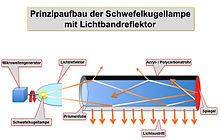Sulfur lamp
A sulfur lamp , also known as a sulfur ball lamp , is an induction lamp and belongs to the category of microwave lamps . It consists of a quartz glass ball filled with traces of sulfur and the noble gas argon . To change the color temperature , small traces of other substances are also added. A plasma is generated in the sphere by microwaves from a magnetron .
construction
In contrast to gas discharge lamps , the sulfur lamp , like all induction lamps and the nullode , does not require electrodes . Because of the high temperatures that arise on the quartz glass of the sphere, it is kept rotating and thereby cooled. This is caused by a lower stem that has fan-shaped fan blades. It rotates in the air flow generated by a fan inside the magnetron. If this cooling fails, the ball would melt after about 20 seconds.
Sulfur lamps achieve a similarly high luminous efficacy as fluorescent lamps . They have a balanced light spectrum with a color temperature of around 5,700 K to 6,000 K and are therefore very effective white light sources. By regulating the power of the magnetron, sulfur lamps can be dimmed well and their color spectrum remains stable.
Due to the high luminous flux, the lamps are usually not installed directly on site. Instead, the light is guided into the room with the help of light guides. That makes this type of lamp easy to maintain.
Presumably because of the comparatively high equipment costs (power supply for magnetron, shielding of microwaves, temperatures), this lamp was not commercially available for a long time. Applications were limited to individual locations with demonstration character. LG Electronics has been producing sulfur lamps since 2006 under the name "Plasma Lighting System" (PLS lamps, also available as sulfur plasma lamps). They are often used as lighting in television studios or as artificial lighting for plants.
Typical system parameters
- Power consumption: 1,400 W
- Ball diameter: approx. 30 mm
- Luminous flux: 135,000 lumens
- Start time: 25 s
- Service life (light source): 60,000 h
- Lifespan (magnetron): 20,000 h
- Luminous efficiency: 95 lm / W
- Color rendering index : 94 CRI
history
The sulfur ball lamp was invented in 1990 by scientists working for Fusion Systems Corporation in Rockville , Maryland . It was further developed by the specially founded US company Fusion Lighting in Rockville, Maryland. By illuminating with a conventional magnetron, as it is also used in microwave ovens , the glass ball begins to shine brightly. This also led to its discovery when an employee of the company placed the filled glass ball in the microwave oven of the research laboratory.
In 1997 the company Fusion Lighting developed a complete system consisting of two spotlights and a light pipe made of reflective polycarbonate (from 3M ). A unit at the Department of Energy in Washington DC was installed in the entrance hall as a demonstration system. This unit, consisting of an 80-meter-long fluorescent tube with headlights at both ends, replaced 240 mercury lamps, which together had an output of approx. 42 kW. The power consumption could be reduced by 72%.
In the Smithsonian -Nationalmuseum in Washington one of the first prototype was exhibited next to the light bulb by Thomas Edison.
In 1998, in cooperation with the US Department of Energy (DOE) , a large test facility with 104 units was built in the aircraft maintenance hangar at Hill Air Force Base (Hill AFB), south of Ogden, Utah, USA. The reflective fiber optic tubes were each approx. 31 m long and each had a 1 kW headlight on both sides.
In 2000, the Fusion Lighting website disappeared. It became known that the light tunnels did not live up to expectations as they turned yellow. Then it became quiet about this invention.
On February 21, 2009, Spiegel reported in its issue on page 128 under the heading lighting technology about eternal light - the sulfur ball lamp . According to this, a British company intends to market the sulfur ball lamp as a headlight in the near future. However, it is already being used by the Korean company HK Industry Co. Ltd. offered as spotlights for floodlight systems and as a lamp for illuminating halls. The power of the spotlights offered for indoor and outdoor use is between 300 watts (street lamps) and 1 kW (floodlights).

